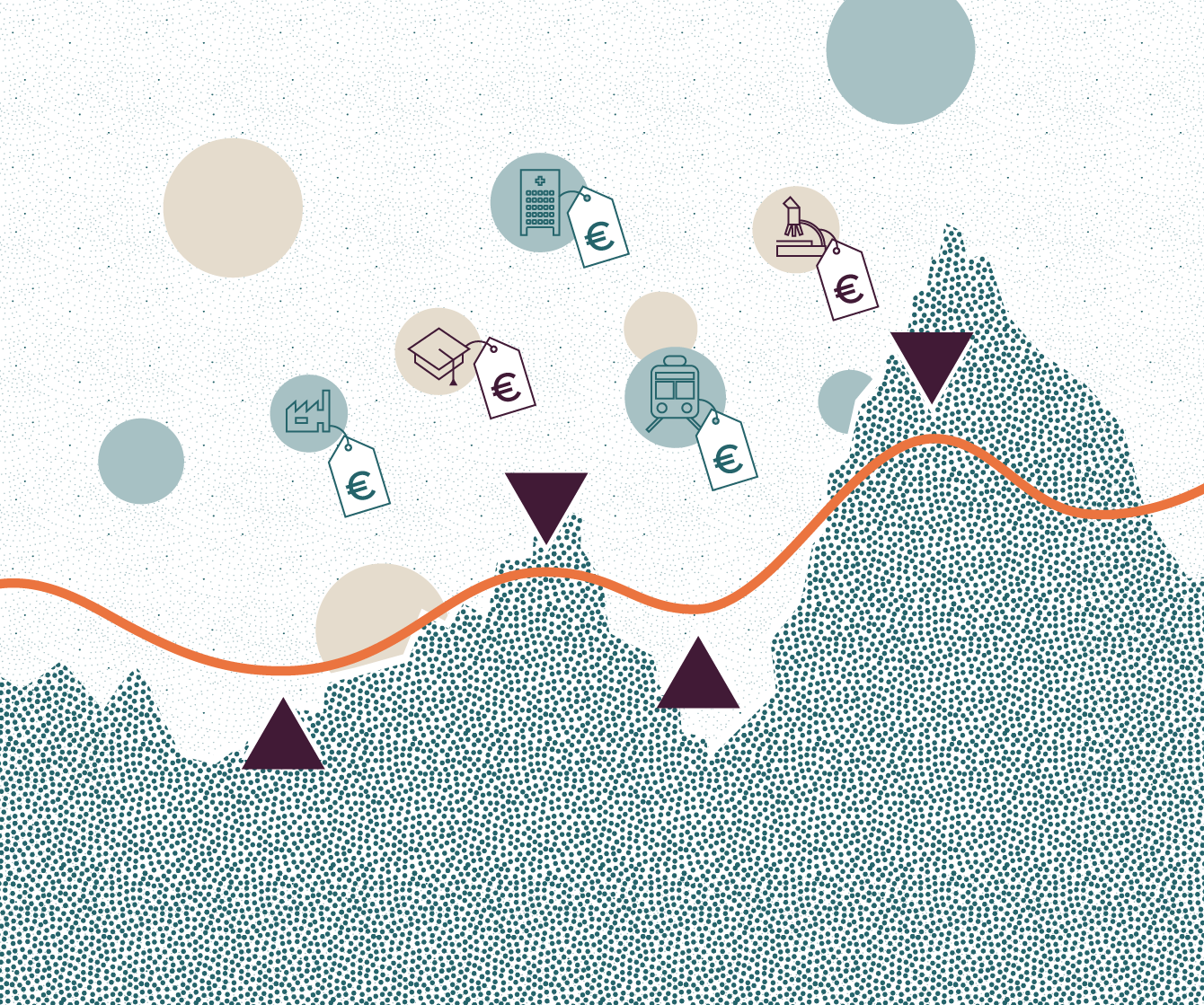Knowledge Base
Financial world
More than a decade after the global financial crisis there still seems to be something seriously wrong with the financial system. Financial markets still tend to periodically misprice risk and contribute to boom and bust cycles. A better financial system needs to discourage short-termism and speculative activity, curtail systemic risk and distribute wealth more broadly.

The Challenge
The 2008 Global Financial Crisis was the worst economic crisis since the Great Depression and the world still suffers from systemic financial instability.
More than eleven years after the collapse of Lehman Brothers and the start of the Global Financial Crisis (GFC), financial markets are yet to return to anything approaching normal. On the one hand, markets are again booming. In July 2019, the Dow Jones closed at a record high of 27,359 points, whereas stock markets around the world have also reached unprecedented highs. Housing prices have also more than recovered from their collapse in 2008. In large cities around the world, real estate prices have literally exploded. Prices for urban residential real estate in Germany, for example, have seen yearly increases of more than 8.5% since 2015 (Bundesbank, 2019). At the same time parts of the financial sector are again making large profits after having been bailed out by the taxpayers in 2008.
Despite these apparent trends, something still seems to be fundamentally wrong with financial markets. Advanced economies today are stuck in a world of ultra-low interest rates, a situation that might persist for many years to come. The global debt burden is increasing steadily, leading some commentators to argue that we could soon face another global financial crisis. The driving force behind the debt increase – as has been the case since the 1950s – is private debt issued by the financial system rather than the public debt of governments. Global debt reached an all-time high of $184 trillion in nominal terms, the equivalent of 225 percent of GDP in 2017. Since the financial crisis, this development has been driven to a large extent by the rise in private debt in emerging markets, in particular by China (IMF, 2019). The ultra-low interest rate environment seems for some commentators to be the only means to sustain this massive private debt overhang and to ensure at least some economic growth (Turner, 2017, 2019).
However, this “New Normal” affects the interest rate margin from which banks draw their profits. The risk of insolvency cannot be underestimated, implying a potential need for further government bail-outs – more than a decade after the crash many financial institutions still remain “too big to fail.” This is particularly the case in Europe, where banks are very big and still suffer from the effects of the GFC and the Euro crisis. Some large German banks have been labelled “zombie banks,” because they are effectively insolvent but can roll over and expand their debts with the help of government guarantees (Kane, 2017). The situation seems to be even more dangerous in Italy, which has been experiencing a hidden banking crisis for several years now. New research shows that such crises can cause substantial credit contractions and lasting economic damage (Baron et al, 2019).
Another risk lies in the steadily increasing size of the financial sector relative to the economy as a whole since the 1960s (Greenwood and Scharfstein, 2013; Phillipon, 2015). Yet it is questionable if finance’s increasing share of GDP is justified by what it contributes to long-term economic progress.
Indeed, it has been suggested that finance’s increasing share has been achieved at the expense of investment in other sectors of the economy as well as in public goods such as education (Temin, 2018).
In that sense, financialization might be contributing to the global productivity slowdown, but also to the rise in inequality and the development of rentier capitalism: Some privileged parts of the population live from asset gains without actually creating wealth themselves. Allowing finance to grow out of proportion to the rest of the economy has been described ‘as eating the family cow in order to have a steak for dinner’ (Temin, 2018); that is, a short-term gain comes at a long-term loss.
A number of experts have also argued that the increasing volatility in financial markets and asset prices has increased the risk for another financial crisis, especially as financial spillovers from the financial sector to the real economy and back have both increased in magnitude since the global financial crisis (Agénor and Pereira da Silva, 2018). The US Federal Reserve injected funds directly into the financial market in September 2019 in an attempt to reduce the rates at which banks are lending to each other. Such a move – the first in ten years – is a clear indication that risk of a next financial crisis is growing.
Together with his colleagues, Moritz Schularick (Jorda et al. 2015) has argued that leveraged housing bubbles have emerged as a particularly harmful phenomenon, and many market observers today are issuing warnings of a housing bubble, including in Germany (Deutsche Bank, 2019b; Financial Times, 2019).
What went wrong
The efficient market hypothesis stipulated that bubbles could not exist and that the market is the best disciplining device.
For more than three decades, economists’ advice to policy makers has been based on a deep belief in the efficiency and stability of financial markets. These markets have been thought of as coming extremely close to the ideal, in which prices provide accurate signals and hence efficient resource allocation. Because markets would efficiently make use of all available information to determine the price of an asset, speculation has been regarded as a way of stabilizing asset prices. The idea that speculation is a stabilizing factor goes back to contributions by Milton Friedman (1953), who reasoned that as soon as prices move away from their equilibrium values, speculators could make money by betting on a price reversal. Speculators would thereby contribute to returning prices to equilibrium. The conclusion was that the less regulated financial markets were, the closer they would be to the ideal market. The growth of the financial sector was thus a sign of its success and finance an important contributor to economic growth.

The main theoretical underpinning of this strongly market-based paradigm were the seminal contributions of Eugene Fama (1965a, 1965b, 1970) and his formulation of the efficient market hypothesis (EMH). According to this hypothesis market prices always reflect a good estimate of an asset’s intrinsic value (Fama, 1965a). This implied that irrational deviations of a price from its fundamental value could only be transitory at best, and that investors could not on average beat the market. Either the aggregate irrationalities of investors would cancel each other out, or rational speculators could make money by betting against irrational behavior.
The more an asset was traded, the more information would thus be incorporated into its price. In other words, higher liquidity generates more information and contributes to the stability of financial markets. This provided the strongest argument for a growing financial sector, the invention of new debt instruments and derivatives, and financial globalization as a whole. And led to the belief that financial crises could only occur in countries with undeveloped financial systems.
It followed from this analysis that the regulation of financial markets was best left to the market itself. The market would act as a disciplining device (Greenspan, 2003), because banks should have a self-interest in protecting the interests of shareholders, As a result, regulation tended to focus on the excessive risk-taking of individual banks and not at the system at large. Under this paradigm irrational exuberance and credit bubbles simply could not exist. As Eugene Fama (2010) said in an interview: “I don’t know what a credit bubble means. I don’t even know what a bubble means. These words have become popular. I don’t think they have any meaning.”
Finally, the deep belief in the efficiency of markets led to the idea that capital should flow freely, and that financial markets would be ever more efficient the bigger they were and the more assets were traded. Increased financial activity was seen as clearly contributing to economic growth.
The Global Financial Crisis (GFC) has dealt a blow to the belief in efficient and self-stabilizing financial markets.
Ever since it occurred, a growing number of eminent economists have questioned this belief. After the worst economic crisis since the Great Depression, it seemed clear that unfettered finance had not delivered on its promise. It was clear that a meltdown of the global financial system in 2008 was only prevented by unprecedented central bank and government intervention. The crisis revealed substantial mispricing of assets linked to the US real estate market and revealed the banking sector’s exposure to systematic risk.
The GFC was preceded by three decades of ever more frequently occurring financial crises around the world, adherents to the then prevailing paradigm had arguably ignored earlier warnings. The Savings and Loans crisis in the US in the 1980s and 1990s, the Asian financial crisis of 1997, Japan’s real estate bubble in the early 1990s and the Dot-Com bubble at the turn of the millennium were difficult to square with the assumptions underlying the EMH. Finally, the increasingly irrational contagion of the eurozone crisis to countries with even solid fundamentals between 2010 and 2012 also contradicted EMH thinking, as well as providing further evidence that financial crises are a recurring phenomenon.
If the frequency of financial crises have increased since the 1970s (see chart), why were banking crises almost absent in the immediate post-war decades? Why have crises occurred more frequently since financial markets have been deregulated? New research has shown that credit growth is a powerful predictor of financial crises, which are often private credit booms gone bust (Schularick and Taylor, 2012).
Contrary to market fundamentalists’ assumptions, asset prices can diverge from their fundamental value for extended periods of time. Prices are not necessarily formed by traders incorporating all the newest information; sometimes they just extrapolate from existing trends. The foundations for a possible new and more market-sceptical paradigm were laid long before the GFC.
In the early 1980s. Robert Shiller (1981) questioned the core assumption of the EHM when he demonstrated that stock markets were a lot more volatile than corporate fundamentals would justify.
These empirical findings supported the influential yet controversial view by Hyman Minsky (1977) and Charles P. Kindleberger (1978) that over-optimism brings about credit expansion. The Minsky-Kindleberger view stipulates that extended periods of economic stability create overly optimistic expectations among investors which create credit bubbles and thereby produce cyclical instability. This view has received much empirical support in recent years (Baron and Xiong, 2017; Mian and Sufi, 2009; Mian et al., 2017; Fahlenbrach et al., 2017).
Until 2008, the Minsky-Kindleberger view had been on the fringe of the economics discipline. However, economists have come to acknowledge that prices do not always reflect perfect information. Indeed, asymmetries exist which can even lead to market failure (Akerlof, 1978; Spence, 1978; Stiglitz and Weiss, 1981). Investors often make decisions about the price at which they are prepared to purchase or sell an asset by employing ‘rules of thumb’ reasoning. This can lead to herding behavior, as investors are influenced by the optimism or pessimism of other investors. In the real world, the strong assumptions of the pre-2008 paradigm do not hold. Instead, as critics like Schularick state, speculation is often destabilizing and the financial system has an inherent tendency towards a boom and bust cycle.
The recent experience of Argentina gives a good illustration of this. In 2017 the housing market in Argentina boomed, only to see a sharp reversal of prices in 2018, leading to sharp fall in the value of the currency and the imposition of capital controls (Bloomberg, 2019). However, boom and bust cycles are not restricted to developing or emerging market economies. According to the latest UBS Global Real Estate Bubble Index, the risk of a housing bubble is particularly strong in the eurozone. Housing prices in Paris, Munich, Frankfurt and Amsterdam are in bubble-risk territory having reached all-time highs (UBS, 2019).
New Economy in Progress

A better financial system needs to counter herding, booms and busts and the inherent tendency towards instability.
New research shows the costs of financial crises and that excessive credit growth produces financial instability. The idea that an ever-larger financial sector increases society’s well-being is now very much in doubt. Indeed, recent academic work indicates that the reverse may be true. A smaller, more regulated financial sector might be better in terms of financial stability and overall economic performance. How can this research help us to build a more resilient financial system?
From a policy perspective, the crash of 2008 revealed that microprudential regulation of individual banks was not enough. Financial regulation and risk management could no longer rely on the market being the main disciplining device, as had been the case before the Great Financial Crisis. If market prices are periodically driven away from their fundamental values, market-based measures can be misleading (Yellen, 2017). Events such as the housing bubble of the 2000s show that prices can diverge from fundamentals for prolonged periods of time. In this case, the banking system as a whole lacked the capacity to absorb the correction in prices when it eventually came.
As a result, economists have therefore agreed on the need for macroprudential management. Since 2008 the discussion has evolved towards higher capital requirements for financial institutions; many economists from across the political spectrum now favor higher capital ratios (see e.g. Admati and Hellwig, 2014). Although some authors have questioned whether higher capital ratios reduce the probability of crisis ex ante, the empirical evidence suggests that higher capital ratios reduce the cost of crises because recovery from a financial crisis is much faster (Jordà ,Schularick & Taylor, 2017). However, we observe not only excess credit growth during economic expansions, but also excessive credit contraction during downturns.
The new paradigm for the financial system needs to acknowledge this pro-cyclicality of the financial system.
One idea that is being discussed in Germany and other countries concerns countercyclical capital buffers. When times are good, banks build up a capital cushion that they can employ during an economic downturn to absorb losses (BIS, 2010; Bundesbank, 2015).
Another policy tool that has gained increasing traction since 2008 is the idea of a financial transaction tax (FTT). Intellectually, the idea can be traced back to Keynes (1936) and Tobin (1974) and was supposed to “throw grains into the wheels of the [foreign exchange] market.” If more financial transactions create financial instability, less trade may be a stabilizing factor. Today, a tax on financial transactions could be justified on the grounds that it would curtail transactions that have a negative social impact and which contribute to system-wide instability; reducing the volume of transactions via a tax might be an option for Zsolt Darvas and Jakob von Weizsäcker (2010).
Finally, since 2008 economists and politicians have discussed the need for a new global financial architecture. Some have called for a new version of the Bretton Woods System, which shaped the post-war era. Such a system would learn from the mistakes of the past, for example by developing an international reserve currency and managing the procyclicality of international capital flows (Stiglitz, 2010). However, the design, structure and implementation of such a system is still subject to debate. Critics have pointed out that focusing on a new Bretton Woods System ignores the importance of large private multinational corporations that transcend national boundaries (Tooze, 2019).
Whatever is agreed, the new paradigm may need to ensure a more transparent financial system, especially regarding so-called shadow banking, and to democratize the interwoven relationship between business and state authority as well as the role of central bankers.







